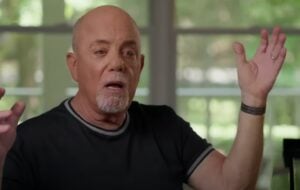How Clint Eastwood Fought Sharks After Plane Crash

via Facts Verse / Youtube
Imagine you’re a young soldier, stationed in California, and you finally snag a coveted leave to visit family. As your luck would have it, you manage to catch a ride back to base on a Navy plane – a seemingly perfect way to end your break. But for actor and director Clint Eastwood, this seemingly fortunate turn of events quickly turned into a harrowing ordeal.
On September 30th, 1951, what started as a simple journey back to Fort Ord, California, became a fight for survival. Eastwood, then a young U.S. Army Private, found himself on a flight plagued by misfortune from the very beginning.
The seemingly routine trip quickly turned into a nightmare, as Eastwood and the pilot faced a series of technical issues and ultimately a terrifying crash landing.
Thrown into the icy waters of the Pacific Ocean, Eastwood and the pilot clung to life in their inflatable rafts. But their struggle wasn’t over yet. Separated by the unforgiving waves, Eastwood found himself facing a grueling swim to shore, relying on an unexpected skill honed during his military service. Little did he know, an even greater danger lurked beneath the surface, waiting to test his resilience.
Trouble right from the moment he took off
Eastwood’s journey back from Seattle, where he’d visited family and a girlfriend, turned into a fight for survival almost from the moment he took off. Aboard a small Navy bomber with pilot Lieutenant Francis Anderson, they encountered immediate trouble. Bad weather forced them to battle turbulence, and the back door malfunctioned, requiring Eastwood to jury-rig it shut with wire. Adding to the tension, the plane’s communication system inexplicably failed.
The situation escalated further as they became lost in fog miles off the coast. With fuel dwindling, Anderson was forced to make a desperate decision – ditch the plane in the ocean, a region notoriously known for its great white shark population.
“Everything went wrong,” Eastwood later recounted to The Hollywood Reporter. “Radios went out. Oxygen ran out. And finally, we ran out of fuel up around Point Reyes, California, and went in the ocean. So we went swimming.”
As the sun dipped below the horizon, the two men watched their aircraft disappear beneath the waves. With only their shoes for paddles, they began the daunting task of swimming towards the distant shore, facing not only the vastness of the ocean but also the unknown dangers lurking beneath the surface.
Desperate swim for survival
As they neared the shore, disaster struck again. The powerful breakers capsized both Eastwood and Lt. Anderson’s life rafts, tossing them into the churning water. Eastwood, separated from his raft, battled the unrelenting waves.
Each attempt to reach land was met with a brutal pushback, the undertow threatening to pull him under. Exhausted and hallucinating from the bioluminescent water, as described by his biographer Richard Schickel, Eastwood clung to hope and continued his fight.
Finally, after what seemed like an eternity, Eastwood managed to reach the shore. Drained and barely able to speak, he stumbled towards an RCA radio station in Point Reyes. Finding him cold, soaked, and in shock, the station workers took him in and offered him warmth and assistance. “The boy was dazed and in a state of shock,” a radio operator recounted to the Daily Independent Journal. “He could hardly speak.”
News of the ordeal spread quickly, and the station workers helped piece together Eastwood’s story. They then drove him to a Coast Guard station where, miraculously, he was reunited with Lt. Anderson, who had also managed to survive the harrowing crash and swim to safety.
Clint had a stint as a lifeguard
Before his brush with death in a plane crash, Clint Eastwood’s life took him through various occupations. From logging and truck driving to serving his country during the Korean War, the young man at the time had faced diverse experiences. Drafted at the age of 21, he found himself stationed at Fort Ord, California.
While most soldiers were shipped off to the Korean peninsula, Eastwood’s fate took a different turn. “Everybody got shipped to Korea except me,” he later recalled. Recognizing an opportunity, he approached his captain with a proposition. “Look, I’m only a private but I think I can handle this swimming pool thing,” he stated.
Eastwood’s past experience as a lifeguard, among his various jobs, proved to be the key factor. His confidence and past skills convinced his commanding officer, and he was assigned the duty of overseeing the base swimming pool.
This seemingly mundane task, away from the dangers of the battlefield, would later play a crucial role in his survival.
Later accounts depicted different stories
Following his two years in the U.S. Army, Clint embarked on a successful acting career in Hollywood. Naturally, his harrowing experience of surviving a plane crash and swimming ashore became a captivating anecdote for his publicists, further solidifying his tough-guy image. However, like many stories retold over time, details surrounding the event began to morph.
Later accounts depicted Eastwood as a lone survivor, swimming directly from the wreckage to the shore, a distance estimated between 3 and 4 miles, without the aid of a life raft. This undoubtedly dramatized the ordeal, amplifying his perceived heroism.
In recent years, however, Eastwood himself has downplayed the severity of the event. He described spotting the Marin County coast from a distance, unsure of the exact distance but estimating it to be “a mile or two,” which significantly reduces the perceived feat. While undeniably a harrowing experience demanding considerable stamina, his revised account offers a more grounded perspective.
Interestingly, the experience of battling the elements and facing potential danger resonated in Eastwood’s work as a director, lending authenticity to scenes depicting similar themes of survival and resilience.
The echoes of his experience in his directing choices
Clint Eastwood’s brush with mortality in a plane crash left a lasting impact not only on his life but also on his work as a director. This is evident in his 2010 film Hereafter, which features a harrowing scene of a near-drowning during a tsunami. The scene’s raw authenticity can be attributed, in part, to Eastwood’s own experience battling the unforgiving ocean.
Six years later, Eastwood helmed Sully, a biopic chronicling the heroic feat of pilot Chesley Sullenberger, who successfully landed a disabled plane on the Hudson River in 2009. Tom Hanks, who portrayed Sullenberger, firmly believed Eastwood was the ideal director for the project.
“He almost died! He almost froze in the water!” Hanks exclaimed to The Hollywood Reporter, emphasizing Eastwood’s unique understanding of the near-death experience depicted in the film.
While Eastwood acknowledged revisiting his own ordeal during the filming process, he downplayed its influence on his decision to direct Sully. He clarified, “I definitely thought about it when I was shooting this… But it had no bearing on me making this movie. I would have shot this movie anyway.”












